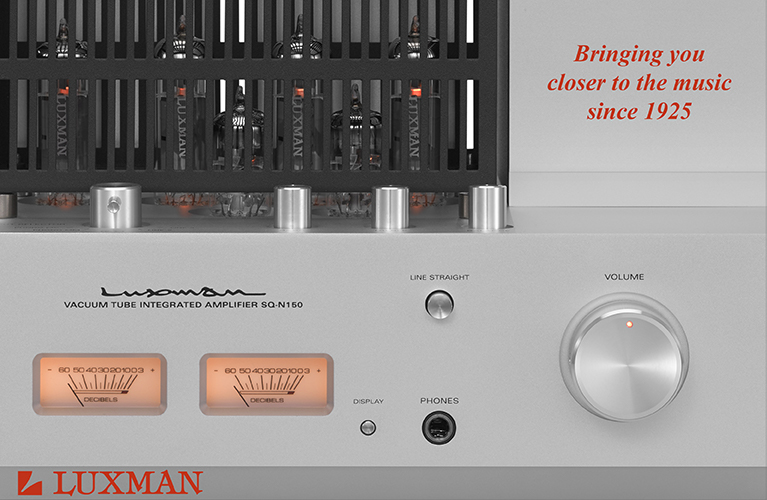Note: for the full suite of measurements from the SoundStage! Audio-Electronics Lab, click this link.
 Phono preamplifiers are something of an oddity in audio, in that many non-audiophiles don’t even realize they exist. They perform a function as critical as any other component in one’s system, but because they’re often a built-in feature of the turntable, receiver, or integrated amplifier, they typically aren’t visible. This is particularly true for entry-level systems. The ability to disappear, at least physically, is not a skill that your amplifier, sources, speakers, cables, power conditioner, isolation devices, and more can lay claim to. However, much like a built-in DAC, phono preamplifiers can easily be hidden away.
Phono preamplifiers are something of an oddity in audio, in that many non-audiophiles don’t even realize they exist. They perform a function as critical as any other component in one’s system, but because they’re often a built-in feature of the turntable, receiver, or integrated amplifier, they typically aren’t visible. This is particularly true for entry-level systems. The ability to disappear, at least physically, is not a skill that your amplifier, sources, speakers, cables, power conditioner, isolation devices, and more can lay claim to. However, much like a built-in DAC, phono preamplifiers can easily be hidden away.
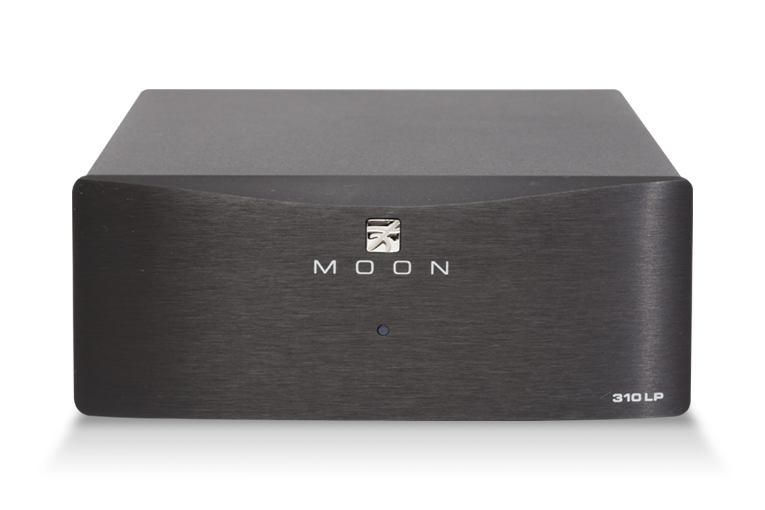
Onboard components make perfect sense for someone who loves listening to music but doesn’t want the hassle or expense of tweaking his or her system to the nth degree to dial the sound in. They make less sense to an audiophile, though. If you’re reading this review, you probably appreciate that having a separate phono preamplifier gives you another way to tweak the sound of your stereo system—and a good one can help to extract better sound from your vinyl. As a reviewer, I find it easier to describe the sound of a phono preamplifier than say, a digital-to-analog converter, which makes it more fun to write about.
At least that’s what I thought, until one evening in mid-January when the temperature outside was below -20°C. A package had showed up on my doorstep with nary a ring of the doorbell to warn me of its arrival. I estimated it had sat outside for 2–3 hours before I brought it in and unpacked a simple metal box whose black steel was so cold it was painful to hold for too long. It was Simaudio’s Moon 310LP ($2300, all prices in USD), a midrange model in the Quebec, Canada, company’s phono preamplifier lineup. I sat the 310LP on the kitchen table overnight to reach room temperature before plugging it in the next morning, hoping that the cold hadn’t affected it.
Description
At $2300, the 310LP is far more expensive than the Moon 110LP v2 ($600) that Thom Moon (no relation!) reviewed in 2018 for SoundStage! Access, but considerably cheaper than the Moon 610LP ($8500) that Jason Thorpe reviewed in 2015 for this site. However, even the 610LP isn’t Simaudio’s best game. That distinction belongs to the 810LP ($13,500) and its optional 820S outboard power supply ($8500). Strictly in terms of dollars and cents, the 310LP is on the low end of Simaudio’s phono-preamplifier hierarchy.
So, what does $2300 buy you? Well, in the plainest terms, a sturdy, midsized, black metal box. The 310LP measures 8.0″W × 3.25″H × 11.0″D and weighs just under seven pounds. A simple brushed-aluminum faceplate displays some branding and the model name, and features a small blue LED in the center that turns on as soon as the unit is plugged in (there is no power switch).
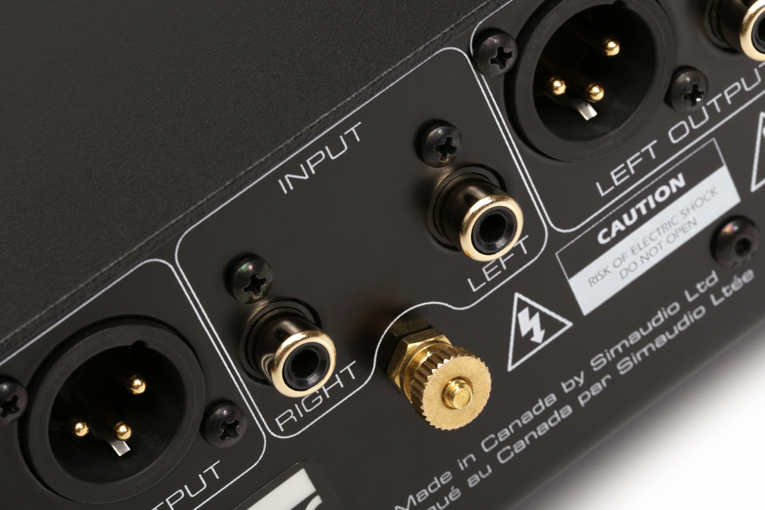
On the back of the unit there is a pair of single-ended RCA inputs, with a ground post located directly beneath them. Flanking them are single-ended RCA and balanced XLR outputs for the left and right channels. Simaudio strongly recommends using the XLR outputs if your preamplifier has balanced inputs, because they offer a higher signal-to-noise ratio and an additional 6dB of gain. My integrated amplifier doesn’t have balanced inputs, so I was unable to take advantage.
A surprisingly stiff and heavy-duty power cable ships with the 310LP and plugs into the IEC receptacle on the backside. There’s also a four-pin XLR DC power input located directly above the IEC receptacle. This was included to accommodate the optional 320S power supply, but as I learned when I reached out to Simaudio, the company has stopped building them. The 320S had been manufactured for many years as an upgrade option for the LP5.3, an earlier version of this phono preamplifier. However, it seems that most customers preferred to move up to the 610LP rather than buy the 310LP with the outboard power supply, making the 320S obsolete when the LP5.3 was discontinued.
As one expects from a phono preamp at this price, the 310LP offers a great deal of flexibility to match it to just about any moving-magnet (MM) or moving-coil (MC) cartridge a potential buyer might own. Resistance loading, capacitance loading, gain level, and the equalization curve can all be adjusted by unscrewing the top cover and moving the jumpers on the circuit board inside. While a magnifying glass would have been handy, I was able to make the adjustments using tweezers and the flashlight on my phone.
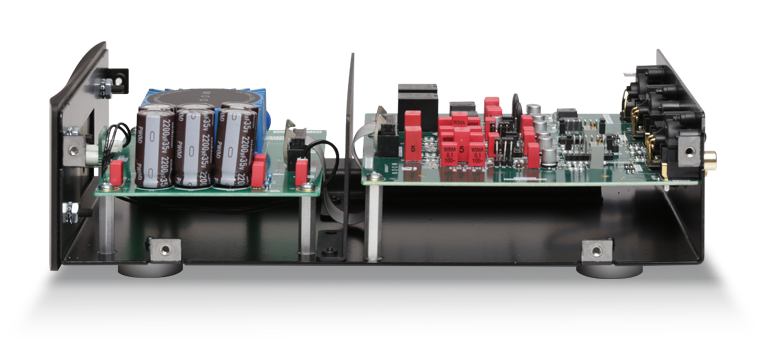
There are five resistive load settings (10, 100, 470, 1k, and 47k ohms) and three choices for capacitance loading (0, 100, and 470pF). Options for equalization include the standard RIAA curve as well as the less common IEC modified curve (the latter curve is essentially the same as the RIAA curve, but incorporates a gentle filter that reduces unwanted rumble, particularly at frequencies below 20Hz). A gain of 40dB is standard for MM cartridges, while gain for MC cartridges can be set at 54, 60, or 66dB. As mentioned earlier, employing the balanced outputs increases each of these values by 6dB.
The 310LP’s four-layer printed circuit board has copper tracings for the dedicated ground and power planes to ensure short signal paths and lower impedance, which, Simaudio says, improves signal accuracy and reduces noise. The board itself is symmetrical and uses closely matched parts throughout.
The power supply is isolated on a separate PCB and features a toroidal transformer and two stages of voltage regulation. A feature the company calls independent inductive DC filtering (i2DCf) is said to increase dynamic range. All of this comes wrapped in a thick metal chassis intended to shield the contents from external vibrations that could otherwise influence the sensitive circuits.
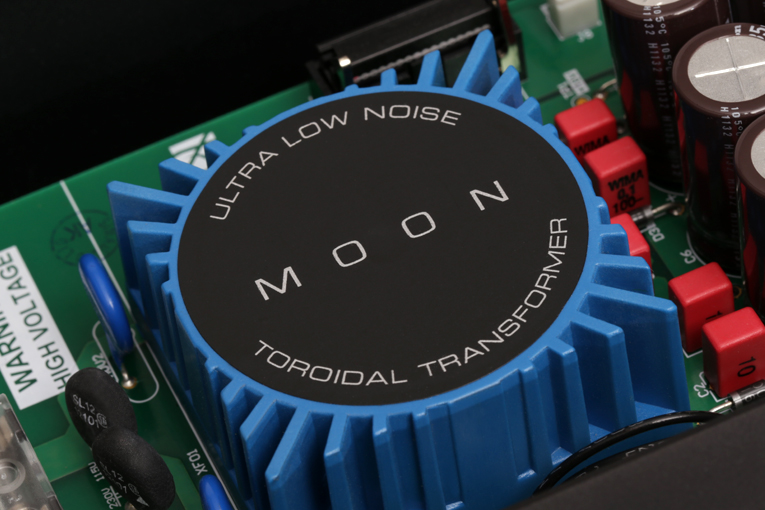
I swapped out my trusty Lehmannaudio Black Cube phono preamplifier and connected the 310LP to my Thorens TD 160 HD turntable using Kimber Kable Tonik RCA interconnects. The Thorens features a modified Rega RB250 tonearm, which sports a Sumiko Songbird Low MC cartridge. Generic RCA cables linked the 310LP to a Bryston B135 SST2 integrated amplifier, and a set of Nirvana Audio Royale speaker wires, terminated in spades, delivered power to a pair of KEF R11 tower speakers. All electronics were plugged into an ExactPower EP15A power conditioner.
Sound
Removing the 310LP’s cover for the first time took some effort as it fit rather snugly. Once it was lifted off and I had access to the circuit board, I set the resistance to 100 ohms and, following Simaudio’s recommendations for an MC cartridge, set the capacitance to 0pF. The RIAA equalization curve is selected by default, and I didn’t bother to change this. However, I tried both the 60dB and 66dB gain settings and I found that 60dB offered sufficient gain for my 0.5mV cartridge.
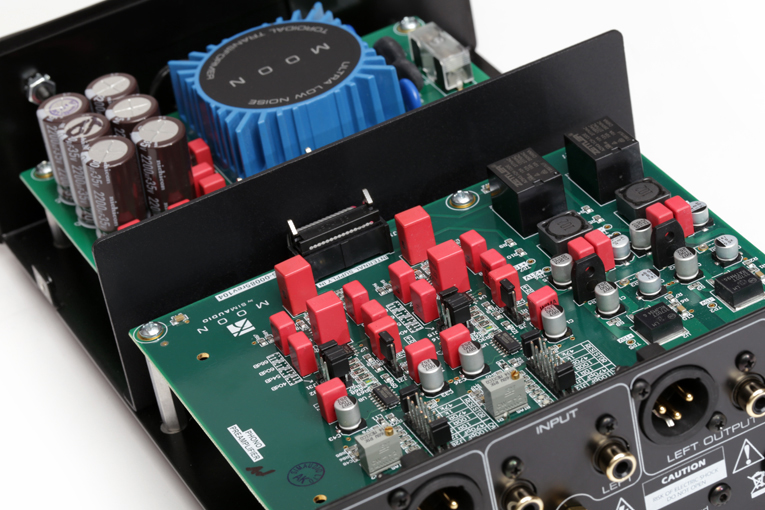
As I set up the 310LP, I was listening to Radiohead’s In Rainbows (TBD records TBD001) through the Lehmannaudio Black Cube. This preamplifier is over 20 years old, but still performs well and gives a clear view into my records. When I was ready, I switched from the Black Cube to the 310LP, and the change wrought by the latter was immediately obvious. “15 Step,” the opening track from In Rainbows, came alive through the 310LP, making the Black Cube sound reticent, even veiled, by comparison. Through the Canadian phono preamplifier, Thom Yorke’s vocals popped forward in the mix, and the same was true of the drums. However, as I came to learn after spending some time with it, the 310LP isn’t really forward, it’s just quiet. Dead quiet, in fact. The Black Cube is a good phono preamplifier, but the superior clarity of the Moon was obvious after hearing them back-to-back. With all my favorite review tracks, the 310LP extracted more information from the grooves.
Listening to Radiohead’s “Nude,” the electric bass was solid and weighty, while the vocals soared from the KEFs during the quieter passages of the song. These dynamic shifts were especially pronounced and easy to appreciate with the 310LP, accentuated by a noise floor that was perceptibly lower than the Black Cube’s.
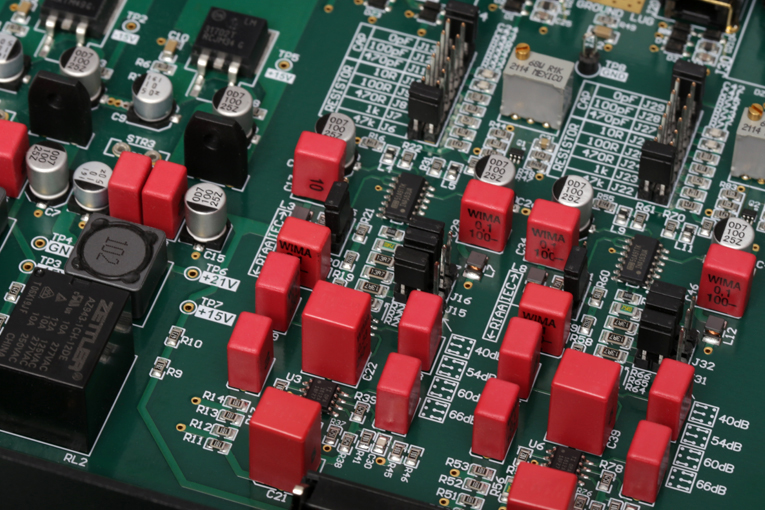
A bigger treat awaited me when I listened to the first side of the 2008 reissue of Charles Mingus’s Ah Um, his first album for Columbia (Columbia Records/Legacy Recordings 8697-33568). The opening tune, “Better Git It in Your Soul,” is explosive, helping Ah Um roar out of the starting blocks with an extraordinary sense of vitality and a frenzied tempo that has you tapping your toe and nodding your head. Through the 310LP, the alto and tenor saxophones were vibrant and shiny rather than bright or harsh. Combined with the rapid-fire drumming they pretty much demanded more volume, which I was happy to oblige. The second song, “Goodbye Pork Pie Hat,” offers a striking counterpoint to “Better Git It in Your Soul.” The mood and rhythm drop precipitously on this brooding and melancholic tribute to saxophonist Lester Young, who had died less than two months before it was recorded. Ah Um is a spacious album, and it was particularly so through the 310LP. It had me thinking about what it must have been like to hear these songs played live in a club.
With that in mind, I put on the Record Store Day 2021 release of Donny Hathaway’s Live (ATCO Records 603497844753, R1 33386) to hear “What’s Goin’ On,” his cover of the Marvin Gaye classic. Recorded in 1972 at the Troubadour, in West Hollywood, California, the sound of the audience is what really defines the dimensions of the stage and the space inside the club. The callouts and applause are infectious, and one can feel the energy in the room. The same is true of “The Ghetto,” one of the standout songs from this performance. I was especially drawn to the percussion, which seemed to invigorate the crowd with its rhythm. For its part, the 310LP wasn’t really doing anything other than letting the music pass through unaltered. I couldn’t find fault with it.
As much as I enjoy writing about gear that requires me to listen to vinyl, the 310LP was challenging because it doesn’t really sound like anything at all. Aside from the black backgrounds it provides, this phono preamplifier doesn’t really have any specific character. So rather than latching onto something distinct about its personality, I was left jotting down notes about the quality of the recordings themselves. The upside was that I spent more time listening with it than I’d planned, and sampled a lot more music than I usually do for an equipment review.
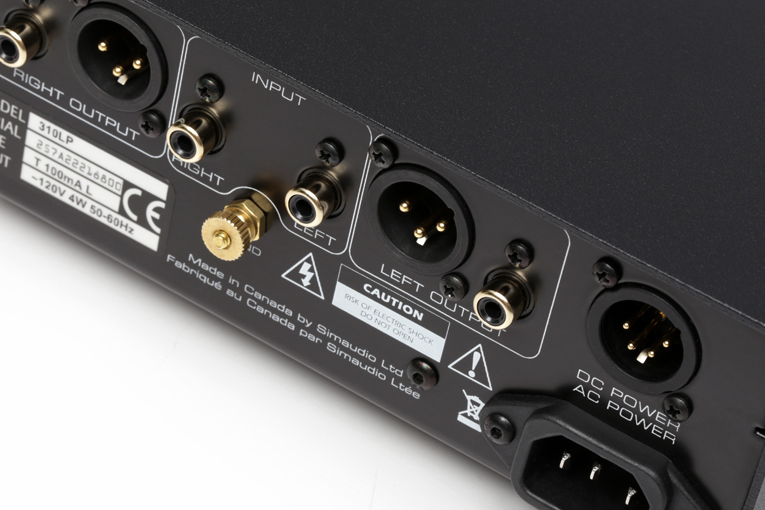
For example, whereas I’d normally use Tom Waits’s Rain Dogs (Island Records LC 0407) as review material, this time I played tracks from Blue Valentine (Asylum Records 6E-162) as well. On “Romeo Is Bleeding,” Tom Waits’s lispy baritone was carved out with precision through the Moon 310LP and served as the song’s focal point, while the tenor sax and the organ added a sense of depth to the soundstage. The rhythm of the congas was taut and their sound was open, and the gently brushed cymbals shimmered. The Moon’s incredibly high resolution made it a cinch to tease apart the locations of the performers at the front of my room.
Feeling in the mood for some rock music, I cued up the Pixies’ Doolittle (4AD CAD 905), an album that had been out for a decade before it ever came onto my radar as a teenager. Lead singer Frank Black doesn’t sound like Tom Waits, save for his sometimes hiss-like vocal delivery; the 310LP conveyed it as vividly as I’ve ever heard it on vinyl. The drums on “Wave of Mutilation” were tight and articulate, with ample space around them. Doolittle is a spacious, incredibly clean-sounding album for what is an otherwise raucous record that encourages healthy (or more correctly, unhealthy) playback levels. As for the Moon, it left no fingerprint on these songs, as the music passed through it unfiltered, essentially stepping aside for the turntable and cartridge to convey their own character, for better or worse.
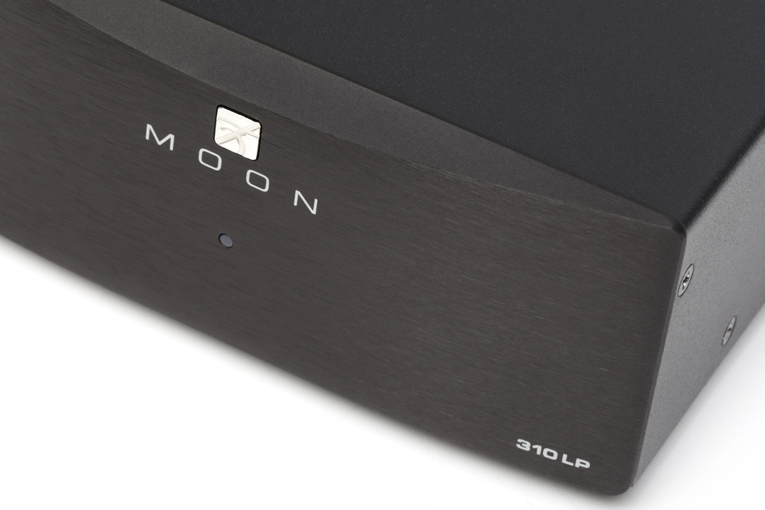
Because the noise floor was lower than I’ve experienced with my own phono preamplifier, the 310LP had me pulling out some of my better-sounding records just to hear what they would sound like. Naturally that meant reaching for a recording of bells, a craving that “Singer Castle Bells,” from the Great Lake Swimmers’ Lost Channels (Nettwerk Productions 0 670 30893 1 9), was able to satiate. Located on Dark Island (what a great name) on the St. Lawrence River, near Chippewa Bay, New York, construction on Singer Castle began in the early 20th century and included a four-story tower that houses said bells. Since the 310LP is so quiet, it was easy to hear not only the ringing of the bells, but also the clicks and creaks of the mechanism used to operate them. I’m not entirely sure why, but I find this short piece relaxing—possibly because I only listen to it when it’s perfectly quiet around me. Using a phono preamplifier that adds so little noise of its own made it that much more enjoyable. On “River’s Edge,” the notes from the piano had a pleasing weight. Along with the soft thump that came from tapping on the body of an acoustic guitar, they built a nice foundation for the vocals, which sounded commendably transparent and natural in front of me. Again, nothing was added, nothing was taken away by the 310LP.
Comparison
For comparison, I borrowed the same Saturn Audio 401 phono preamplifier that Jason Thorpe reviewed on March 15. Retailing at $2900, the 401 is a two-box affair with an outboard power supply and occupies a footprint over three times that of the 310LP. It was sent to me with its resistance set to 100 ohms and gain at 67dB. Since I’d been using the Moon with 60dB gain, I opened the 310LP again and adjusted the gain to 66dB to match the Saturn more closely.
Spiritualized’s Pure Phase (Fat Possum Records FP1752-3) is an album I’ve recently acquired on vinyl after owning it for many years on CD. After playing “Medication” through the 310LP, I flipped over to the Saturn and cued up the tune once again. What immediately became apparent was that the Saturn was rounder in its delivery of the bass line and the sound was a bit fuller overall. Through both phono stages the organ notes hung suspended in space, but with the Saturn the music bloomed more, whereas the Moon seemed a bit drier and more precise. Both phono stages served up loads of detail and delivered outstanding clarity—as demonstrated by the ringing of what I think was a triangle near the beginning of the tune, which both components presented with plenty of space around it.
Returning to “Better Git It in Your Soul,” the drumming is manic as Dannie Richmond maintains an incredibly high cadence that propels the tune forward. The music popped out of the speakers through both phono preamps; their clarity revealed incredible detail, not the least of which was the location of each musician on the stage and their distances from my listening chair. Again, I found the Saturn had a rounder character than the Moon, without managing to sound soft or indistinct, whereas the 310LP was a touch more incisive. I only have a small jazz collection but it makes a disproportionately large contribution to the list of the best-sounding LPs I own. Ah Um is sublime and I’m here to report that if the rest of your system is game, this record will sound phenomenal through either phono preamplifier. I kept changing my mind about which one I preferred, and began to wonder whether spending more money really buys a better-sounding product, or simply one that sounds different.
Conclusion
The 310LP sounds as nondescript as it looks and is not ideal for someone looking to color the sonics of their system. If you’re happy with your analog frontend and don’t want to change anything, this is an easy recommendation. What it will do is help you hear what you already enjoy about your turntable/tonearm/cartridge combo more clearly, because it’s exceptionally quiet. If there’s something more dramatic you want to change about the way you hear your records, move along, because you won’t find it here.
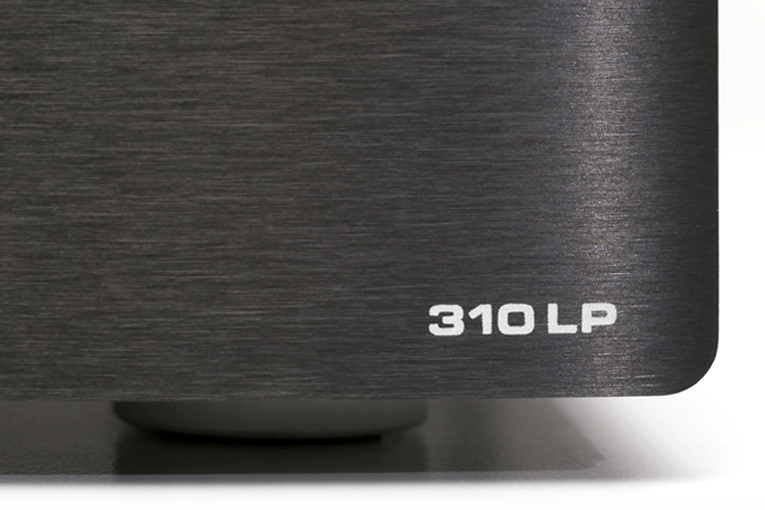
I started this review by suggesting that phono preamplifiers tend to be overlooked by non-audiophiles because they’re often built into another component. Simaudio’s Moon 310LP can’t disappear physically, but owing to its quiet operation and neutral signature, it vanishes sonically. In my opinion, this makes owning it a long-term investment; if you decide to upgrade a frontend component, this preamplifier’s role will be to reveal those changes so you can hear the impact they are having upstream. This means that when you find a turntable setup that you like, the 310LP will reveal its true sound, rather than color it.
. . . Philip Beaudette
philipb@soundstagenetwork.com
Note: for the full suite of measurements from the SoundStage! Audio-Electronics Lab, click this link.
Associated Equipment
- Speakers: KEF R11.
- Integrated amplifier: Bryston B135 SST2.
- Analog source: Thorens TD 160 HD turntable, Rega Research RB250 tonearm, Sumiko Songbird Low MC cartridge.
- Phono stage: Saturn Audio 401, Lehmannaudio Black Cube.
- Speaker cables: Nirvana Audio Royale.
- Interconnects: Kimber Kable Tonik.
- Power conditioner: ExactPower EP15A.
Simaudio Moon 310LP Phono Preamplifier
Price: $2300.
Warranty: Ten years, parts and labor (with registration).
Simaudio Ltd.
1345 Newton Road
Boucherville, Quebec J4B 5H2
Canada
Phone: (450) 449-2212
Email: sales@simaudio.com
Website: www.simaudio.com






















